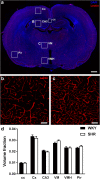Blood-brain and blood-cerebrospinal fluid barrier permeability in spontaneously hypertensive rats
- PMID: 30244677
- PMCID: PMC6151927
- DOI: 10.1186/s12987-018-0112-7
Blood-brain and blood-cerebrospinal fluid barrier permeability in spontaneously hypertensive rats
Abstract
Background: Hypertension is an important risk factor for cerebrovascular disease, including stroke and dementia. Both in humans and animal models of hypertension, neuropathological features such as brain atrophy and oedema have been reported. We hypothesised that cerebrovascular damage resulting from chronic hypertension would manifest itself in a more permeable blood-brain barrier and blood-cerebrospinal fluid barrier. In addition, more leaky barriers could potentially contribute to an enhanced interstitial fluid and cerebrospinal fluid formation, which could, in turn, lead to an elevated intracranial pressure.
Methods: To study this, we monitored intracranial pressure and estimated the cerebrospinal fluid production rate in spontaneously hypertensive (SHR) and normotensive rats (Wistar Kyoto, WKY) at 10 months of age. Blood-brain barrier and blood-cerebrospinal fluid barrier integrity was determined by measuring the leakage of fluorescein from the circulation into the brain and cerebrospinal fluid compartment. Prior to sacrifice, a fluorescently labelled lectin was injected into the bloodstream to visualise the vasculature and subsequently study a number of specific vascular characteristics in six different brain regions.
Results: Blood and brain fluorescein levels were not different between the two strains. However, cerebrospinal fluid fluorescein levels were significantly lower in SHR. This could not be explained by a difference in cerebrospinal fluid turnover, as cerebrospinal fluid production rates were similar in SHR and WKY, but may relate to a larger ventricular volume in the hypertensive strain. Also, intracranial pressure was not different between SHR and WKY. Morphometric analysis of capillary volume fraction, number of branches, capillary diameter, and total length did not reveal differences between SHR and WKY.
Conclusion: In conclusion, we found no evidence for blood-brain barrier or blood-cerebrospinal fluid barrier leakage to a small solute, fluorescein, in rats with established hypertension.
Keywords: Blood–brain barrier; Blood–cerebrospinal fluid barrier; Cerebrospinal fluid; Hypertension; Interstitial fluid.
Figures



Similar articles
-
Time course of hyperosmolar opening of the blood-brain and blood-CSF barriers in spontaneously hypertensive rats.J Vasc Res. 2007;44(2):99-109. doi: 10.1159/000098260. Epub 2006 Dec 28. J Vasc Res. 2007. PMID: 17191032
-
Increased brain uptake and CSF clearance of 14C-glutamate in spontaneously hypertensive rats.Brain Res. 2003 Dec 24;994(2):181-7. doi: 10.1016/j.brainres.2003.09.034. Brain Res. 2003. PMID: 14642643
-
Effect of hypertension on the integrity of blood brain and blood CSF barriers, cerebral blood flow and CSF secretion in the rat.Brain Res. 2003 Jun 13;975(1-2):179-88. doi: 10.1016/s0006-8993(03)02632-5. Brain Res. 2003. PMID: 12763606
-
Fluid and ion transfer across the blood-brain and blood-cerebrospinal fluid barriers; a comparative account of mechanisms and roles.Fluids Barriers CNS. 2016 Oct 31;13(1):19. doi: 10.1186/s12987-016-0040-3. Fluids Barriers CNS. 2016. PMID: 27799072 Free PMC article. Review.
-
Fluid Dynamics Inside the Brain Barrier: Current Concept of Interstitial Flow, Glymphatic Flow, and Cerebrospinal Fluid Circulation in the Brain.Neuroscientist. 2019 Apr;25(2):155-166. doi: 10.1177/1073858418775027. Epub 2018 May 25. Neuroscientist. 2019. PMID: 29799313 Free PMC article. Review.
Cited by
-
Investigating the Interplay between Cardiovascular and Neurodegenerative Disease.Biology (Basel). 2024 Sep 26;13(10):764. doi: 10.3390/biology13100764. Biology (Basel). 2024. PMID: 39452073 Free PMC article. Review.
-
Investigating changes in blood-cerebrospinal fluid barrier function in a rat model of chronic hypertension using non-invasive magnetic resonance imaging.Front Mol Neurosci. 2022 Sep 2;15:964632. doi: 10.3389/fnmol.2022.964632. eCollection 2022. Front Mol Neurosci. 2022. PMID: 36117909 Free PMC article.
-
Spontaneously hypertensive rats can become hydrocephalic despite undisturbed secretion and drainage of cerebrospinal fluid.Fluids Barriers CNS. 2023 Jul 4;20(1):53. doi: 10.1186/s12987-023-00448-x. Fluids Barriers CNS. 2023. PMID: 37403103 Free PMC article.
-
Effect of long-term antihypertensive treatment on cerebrovascular structure and function in hypertensive rats.Sci Rep. 2023 Mar 1;13(1):3481. doi: 10.1038/s41598-023-30515-0. Sci Rep. 2023. PMID: 36859481 Free PMC article.
-
Altered Expression of AQP1 and AQP4 in Brain Barriers and Cerebrospinal Fluid May Affect Cerebral Water Balance during Chronic Hypertension.Int J Mol Sci. 2022 Oct 14;23(20):12277. doi: 10.3390/ijms232012277. Int J Mol Sci. 2022. PMID: 36293145 Free PMC article.
References
MeSH terms
LinkOut - more resources
Full Text Sources
Other Literature Sources
Medical

